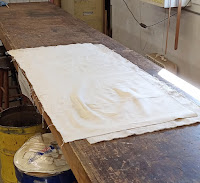We all need to vent now and then. And I, for one, am working to make it easier.
I still needed some more canvas paint mixed, but that should be arriving soon. In the meantime, there's plenty of other things to do on the 460. One of them, as mentioned last time, is installing a second layer of canvas where a trainman climbs up on the folding steps to gain access to the roof. On the St. Louis cars, theres' a second layer of canvas to protect the roof. So those have to be installed.
Here's a picture from last week. One of the canvas pieces I cut out was badly wrinkled.
Wrinkles on the end of the roof canvas are a real pain. But it's about ten times easier and more effective to iron when the work is on a level surface, as one usually does when ironing clothes. So this piece is now ready for installation.
But since the car needs ventilation, I decided to start installing the vents. This car has three of them. The first step is to cut out the canvas.
I've complained about this next problem before. These vents are attached with an unreasonable number of wood screws, spaced about 1/2" apart. It takes a lot of time and effort to fasten them all down.
But I was able to finish installing two of them.
Let's turn to what the other guys were doing. It's quite noticeable that the roof of the 1808 is badly bowed downward where the trolley bases are mounted.
After Tim removed the ceiling, the answer is obvious: the carlines have cracked and are being bent downwards. This will be fixed, of course.
The reason for this is historical. The 1268, 1797, and 1808 were built as part of the same order, as simple trailers meant to be pulled by motor cars. They were later converted to control trailers, as the 1268 still is. In 1913, the 1797 and 1808 were converted to half-motors, and therefore had poles installed. The original roof structure wasn't designed to support poles, and has weakened with age. (Who hasn't?) In any case, this will be repaired.
And other people were hard at work as well. Gerry was busy installing insulation along the walls of the 306, as seen here:
This then gets covered with wallboard:
Mike spent the day needle-chipping the trucks on the 1808, and Frank continued on the seat frames and other interior parts. Jim was cleaning up drip rails and other roof parts for the 306:
Gregg spent much of the day running the big mortiser to make new windows for the IT line car.
And now it's time for me to vent. It sure was noisy today! Between Mike needle-chipping, Tim sanding down window frames, Jim wire-wheeling drip rails, the radio blaring, and me pounding tacks, I could hardly hear myself think. That's why I always have earmuffs at hand. But with a little rest and relaxation, it'll be back to work soon. And if you need to vent, you can always leave a comment!
















2 comments:
Since I'm commenting on the Hicks blog this evening, I might as well comment on this entry. Almost all of the early 'L' cars had only two motors, other than a few of the early cars that were locomotive cars before MU control was invented. The first 4-motor cars were the 6000s (and of course 8-motors on the articulated cars). The Rapid Transit used high horsepower motors (170hp on WH 4000s) capable of pulling at least one trailer. Of course they did not operate at high speeds like the interurbans.
Hello it’s Michael Hudoc and I need to vent:)) Sorry this comment is unrelated to the above post. I received the fall 2022 of Rail & Wire…. What an AWESOME publishing job!!!!! I don’t know who is involved in putting that magazine together but they need to be recognized. Highlighting volunteers and the hard work they put in and busting up there bodies for a cause:))) I just want to say I’m proud of the work I do and equally proud of the people around me. All volunteers… Keep up the good work as we all… no matter what barn you’re in… we all are moving forward:)))
Post a Comment